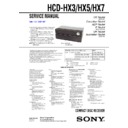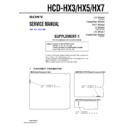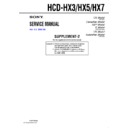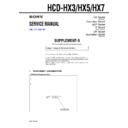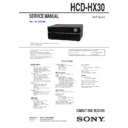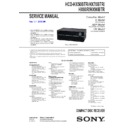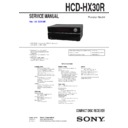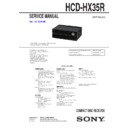Sony HCD-HX3 / HCD-HX5 / HCD-HX7 Service Manual ▷ View online
SERVICE MANUAL
Amplier section
DIN power output (rated):
60 + 60 watts (4 ohms at 1 kHz, DIN)
Continuous RMS power output
(reference): 75 + 75 watts (4 ohms at
1 kHz, 10% THD)
60 + 60 watts (4 ohms at 1 kHz, DIN)
Continuous RMS power output
(reference): 75 + 75 watts (4 ohms at
1 kHz, 10% THD)
Inputs:
AUDIO IN (stereo mini jack):
voltage 250 mV, impedance 47
kilohms
voltage 250 mV, impedance 47
kilohms
(USB) port: Type A, maximum
current 500 mA
Outputs:
PHONES (stereo mini jack): accepts
headphones of 8 ohms or more
SPEAKER: accepts impedance of
4 ohms
headphones of 8 ohms or more
SPEAKER: accepts impedance of
4 ohms
Bluetooth section (HCD-HX5/HX7)
Communication system:
Bluetooth Standard version 2.0
Output:
Bluetooth Standard Power Class 2
Maximum communication range:
Line of sight approx. 10 m
1)
Frequency band:
2.4 GHz band (2.4000 GHz –
2.4835 GHz)
2.4835 GHz)
Modulation method:
FHSS
Compatible Bluetooth proles
2)
:
A2DP (Advanced Audio Distribution
Profile)
AVRCP (Audio Video Remote
Control Profile)
Profile)
AVRCP (Audio Video Remote
Control Profile)
Supported codecs:
Receive: SBC (Sub Band Codec), MP3
Transmit: SBC (Sub Band Codec)
Transmit: SBC (Sub Band Codec)
1)
The actual range will vary depending on
factors such as obstacles between devices,
magnetic fields around a microwave oven,
static electricity, reception sensitivity,
antenna’s performance, operating system,
software application, etc.
magnetic fields around a microwave oven,
static electricity, reception sensitivity,
antenna’s performance, operating system,
software application, etc.
2)
Bluetooth standard proles indicate the
purpose of Bluetooth communication
between devices.
between devices.
USB section (HCD-HX3/HX5)
Supported bit rate
MP3 (MPEG 1 Audio Layer-3):
32 – 320 kbps, VBR
ATRAC: 48 – 352 kbps
(ATRAC3plus), 66/105/132 kbps
(ATRAC3)
WMA: 32 – 192 kbps, VBR
AAC: 48 – 320 kbps
32 – 320 kbps, VBR
ATRAC: 48 – 352 kbps
(ATRAC3plus), 66/105/132 kbps
(ATRAC3)
WMA: 32 – 192 kbps, VBR
AAC: 48 – 320 kbps
Sampling frequencies
MP3 (MPEG 1 Audio Layer-3):
32/44.1/48 kHz
ATRAC: 44.1 kHz
WMA: 44.1 kHz
AAC: 44.1 kHz
32/44.1/48 kHz
ATRAC: 44.1 kHz
WMA: 44.1 kHz
AAC: 44.1 kHz
CD player section
System: Compact disc and digital audio
system
Laser Diode Properties
system
Laser Diode Properties
Emission duration: continuous
Laser Output*: Less than 44.6
Laser Output*: Less than 44.6
µW
* This is output is the value measurement
at a distance of 200mm from the
objective lens surface on the Optical
Pick-up Block with 7mm aperture.
objective lens surface on the Optical
Pick-up Block with 7mm aperture.
Frequency response: 20 Hz – 20 kHz
Signal-to-noise ratio: More than 90 dB
Dynamic range: More than 90 dB
Signal-to-noise ratio: More than 90 dB
Dynamic range: More than 90 dB
Tuner section
FM stereo, FM/AM superheterodyne tuner
FM tuner section:
Tuning range
US, Canadian models: 87.5 – 108.0 MHz
(100 kHz step)
Other models: 87.5 – 108.0 MHz
(50 kHz step)
(100 kHz step)
Other models: 87.5 – 108.0 MHz
(50 kHz step)
Antenna: FM lead antenna
Antenna terminals: 75 ohms unbalanced
Intermediate frequency: 10.7 MHz
Antenna terminals: 75 ohms unbalanced
Intermediate frequency: 10.7 MHz
AUDIO POWER SPECIFICATIONS
– HCD-HX7 –
– HCD-HX7 –
– HCD-HX5 –
– HCD-HX3 –
POWER OUTPUT AND TOTAL
HARMONIC DISTORTION:
(The United States model only)
With 6 ohm loads, both channels driven,
from 120 – 10,000 Hz; rated 50 watts per
channel minimum RMS power, with no
more than 10% total harmonic distortion
from 250 milliwatts to rated output.
HARMONIC DISTORTION:
(The United States model only)
With 6 ohm loads, both channels driven,
from 120 – 10,000 Hz; rated 50 watts per
channel minimum RMS power, with no
more than 10% total harmonic distortion
from 250 milliwatts to rated output.
Continuous RMS power output
(reference): 50 + 50 watts (6 ohms at
1 kHz, 10% THD)
(reference): 50 + 50 watts (6 ohms at
1 kHz, 10% THD)
Inputs:
AUDIO IN (stereo mini jack):
voltage 250 mV, impedance 47
kilohms
voltage 250 mV, impedance 47
kilohms
Outputs:
PHONES (stereo mini jack): accepts
Canadian, Australian, Korean models:
European model:
headphones of 8 ohms or more
SPEAKER: accepts impedance of
6 ohms
SPEAKER: accepts impedance of
6 ohms
DIN power output (rated):
60 + 60 watts (4 ohms at 1 kHz, DIN)
Continuous RMS power output
(reference): 75 + 75 watts (4 ohms at
1 kHz, 10% THD)
Music power output (reference):
75 + 75 watts (4 ohms at 1 kHz, 10%
THD)
60 + 60 watts (4 ohms at 1 kHz, DIN)
Continuous RMS power output
(reference): 75 + 75 watts (4 ohms at
1 kHz, 10% THD)
Music power output (reference):
75 + 75 watts (4 ohms at 1 kHz, 10%
THD)
Canadian model:
DIN power output (rated): 40 + 40
watts (6 ohms at 1 kHz, DIN)
Continuous RMS power output
(reference): 50 + 50 watts (6 ohms at
1 kHz, 10% THD)
watts (6 ohms at 1 kHz, DIN)
Continuous RMS power output
(reference): 50 + 50 watts (6 ohms at
1 kHz, 10% THD)
European model:
DIN power output (rated): 40 + 40
watts (6 ohms at 1 kHz, DIN)
Continuous RMS power output
(reference): 50 + 50 watts (6 ohms at
1 kHz, 10% THD)
Music power output (reference): 50 +
50 watts (6 ohms at 1 kHz, 10% THD)
watts (6 ohms at 1 kHz, DIN)
Continuous RMS power output
(reference): 50 + 50 watts (6 ohms at
1 kHz, 10% THD)
Music power output (reference): 50 +
50 watts (6 ohms at 1 kHz, 10% THD)
Inputs:
AUDIO IN (stereo mini jack):
voltage 250 mV, impedance
47 kilohms
voltage 250 mV, impedance
47 kilohms
(USB) port: Type A, maximum
current 500 mA
Outputs:
PHONES (stereo mini jack): accepts
headphones of 8 ohms or more
SPEAKER: accepts impedance of
6 ohms
headphones of 8 ohms or more
SPEAKER: accepts impedance of
6 ohms
Model Name Using Similar Mechanism
NEW
Base Unit Name HCD-HX7
BU-K6BD90-WOD
HCD-HX3: CND, AEP/HX5
BU-K6BD90U-WOD
HCD-HX3: E, E51, MX, AR, RU BU-K6BD91UR-WOD
Optical Pick-Up Block Name
KSM-213DCP
COMPACT DISC RECEIVER
HCD-HX3/HX5/HX7
SPECIFICATIONS
9-887-618-04
2007G05-1
© 2007.07
© 2007.07
Sony Corporation
Personal Audio Division
Published by Sony Techno Create Corporation
Published by Sony Techno Create Corporation
•
HCD-HX3 (Canadian and AEP models) is the
amplifier, USB, CD player and tuner section
in CMT-HX3.
amplifier, USB, CD player and tuner section
in CMT-HX3.
•
HCD-HX3 (E, Mexican, Chilean, Peruvian,
Argentina and Russian models) is the
amplifier, USB, CD player and tuner section
in CMT-HX3R.
Argentina and Russian models) is the
amplifier, USB, CD player and tuner section
in CMT-HX3R.
•
HCD-HX5 is the amplifier, bluetooth, USB,
CD player and tuner section in CMT-HX5BT.
CD player and tuner section in CMT-HX5BT.
•
HCD-HX7 is the amplifier, bluetooth, CD
player and tuner section in CMT-HX7BT.
player and tuner section in CMT-HX7BT.
Note: Refer to supplement-2 for HCD-HX3 of
CMT-HX3R.
Photo: HCD-HX3
(for CMT-HX3)
Ver. 1.3 2007.07
US Model
HCD-HX7
Canadian Model
AEP Model
E Model
HCD-HX3/HX5
UK Model
Australian Model
HCD-HX5
– Continued on next page –
• The Bluetooth word mark and logos are owned by the Bluetooth SIG, Inc.
and any use of such marks by Sony Corporation is under license. Other
trademarks and trade names are those of their respective owners.
trademarks and trade names are those of their respective owners.
• “WALKMAN” and “WALKMAN” logo are registered trademarks of Sony Corporation.
• MICROVAULT is a trademark of Sony Corporation.
• ATRAC, ATRAC3, ATRAC3plus and their logos are trademarks of Sony Corporation.
• U.S. and foreign patents licensed from Dolby Laboratories.
• MPEG Layer-3 audio coding technology and patents licensed from
Fraunhofer IIS and Thomson.
• The XM name and related logos are registered trademarks of XM Satellite Radio Inc.
• (c) 2006 SIRIUS Satellite Radio Inc. “SIRIUS” and the SIRIUS dog logo
are registered trademarks of SIRIUS Satellite Radio Inc.
TM
®
• and marks are omitted in this manual.
• Abbreviation
AR
: Argentina model
CND : Canadian model
E51
E51
: Chilean and Peruvian models
MX
: Mexican model
RU
: Russian model
2
HCD-HX3/HX5/HX7
Notes on chip component replacement
• Never reuse a disconnected chip component.
• Notice that the minus side of a tantalum capacitor may be
damaged by heat.
Flexible Circuit Board Repairing
• Keep the temperature of the soldering iron around 270 ˚C
during repairing.
• Do not touch the soldering iron on the same conductor of the
circuit board (within 3 times).
• Be careful not to apply force on the conductor when soldering
or unsoldering.
CAUTION
Use of controls or adjustments or performance of procedures
other than those specified herein may result in hazardous radiation
exposure.
other than those specified herein may result in hazardous radiation
exposure.
SAFETY-RELATED COMPONENT WARNING!!
COMPONENTS IDENTIFIED BY MARK
0
OR DOTTED LINE
WITH MARK
0
ON THE SCHEMATIC DIAGRAMS AND IN
THE PARTS LIST ARE CRITICAL TO SAFE OPERATION.
REPLACE THESE COMPONENTS WITH SONY PARTS WHOSE
PART NUMBERS APPEAR AS SHOWN IN THIS MANUAL OR
IN SUPPLEMENTS PUBLISHED BY SONY.
REPLACE THESE COMPONENTS WITH SONY PARTS WHOSE
PART NUMBERS APPEAR AS SHOWN IN THIS MANUAL OR
IN SUPPLEMENTS PUBLISHED BY SONY.
ATTENTION AU COMPOSANT AYANT RAPPORT
À LA SÉCURITÉ!
LES COMPOSANTS IDENTIFIÉS PAR UNE MARQUE
0
SUR
LES DIAGRAMMES SCHÉMATIQUES ET LA LISTE DES
PIÈCES SONT CRITIQUES POUR LA SÉCURITÉ DE
FONCTIONNEMENT. NE REMPLACER CES COM- POSANTS
QUE PAR DES PIÈCES SONY DONT LES NUMÉROS SONT
DONNÉS DANS CE MANUEL OU DANS LES SUPPLÉMENTS
PUBLIÉS PAR SONY.
PIÈCES SONT CRITIQUES POUR LA SÉCURITÉ DE
FONCTIONNEMENT. NE REMPLACER CES COM- POSANTS
QUE PAR DES PIÈCES SONY DONT LES NUMÉROS SONT
DONNÉS DANS CE MANUEL OU DANS LES SUPPLÉMENTS
PUBLIÉS PAR SONY.
SAFETY CHECK-OUT
After correcting the original service problem, perform the following
safety check before releasing the set to the customer:
Check the antenna terminals, metal trim, “metallized” knobs, screws,
and all other exposed metal parts for AC leakage.
Check leakage as described below.
safety check before releasing the set to the customer:
Check the antenna terminals, metal trim, “metallized” knobs, screws,
and all other exposed metal parts for AC leakage.
Check leakage as described below.
LEAKAGE TEST
The AC leakage from any exposed metal part to earth ground and
from all exposed metal parts to any exposed metal part having a
return to chassis, must not exceed 0.5 mA (500 microamperes.).
Leakage current can be measured by any one of three methods.
from all exposed metal parts to any exposed metal part having a
return to chassis, must not exceed 0.5 mA (500 microamperes.).
Leakage current can be measured by any one of three methods.
1. A commercial leakage tester, such as the Simpson 229 or RCA
WT-540A. Follow the manufacturers’ instructions to use these
instruments.
instruments.
2. A battery-operated AC milliammeter. The Data Precision 245
digital multimeter is suitable for this job.
3. Measuring the voltage drop across a resistor by means of a
VOM or battery-operated AC voltmeter. The “limit” indication
is 0.75 V, so analog meters must have an accurate low-voltage
scale. The Simpson 250 and Sanwa SH-63Trd are examples
of a passive VOM that is suitable. Nearly all battery operated
digital multimeters that have a 2 V AC range are suitable. (See
Fig. A)
is 0.75 V, so analog meters must have an accurate low-voltage
scale. The Simpson 250 and Sanwa SH-63Trd are examples
of a passive VOM that is suitable. Nearly all battery operated
digital multimeters that have a 2 V AC range are suitable. (See
Fig. A)
Fig. A.
Using an AC voltmeter to check AC leakage.
1.5 k
Ω
0.15
µ
F
AC
voltmeter
(0.75 V)
voltmeter
(0.75 V)
To Exposed Metal
Parts on Set
Parts on Set
Earth Ground
This is appliance is classied as a CLASS 1
LASER product. This is marking is located
on the rear exterior.
LASER product. This is marking is located
on the rear exterior.
AM tuner section:
Tuning range
US, Canadian models:
530 – 1,710 kHz (with 10 kHz tuning
interval)
531 – 1,710 kHz (with 9 kHz tuning
interval)
530 – 1,710 kHz (with 10 kHz tuning
interval)
531 – 1,710 kHz (with 9 kHz tuning
interval)
Other models:
530 – 1,710 kHz (with 10 kHz tuning
interval)
530 – 1,710 kHz (with 10 kHz tuning
interval)
European model:
531 – 1,602 kHz (with 9 kHz tuning
interval)
531 – 1,602 kHz (with 9 kHz tuning
interval)
531 – 1,602 kHz (with 9 kHz tuning
interval)
interval)
Antenna: AM loop antenna, external
antenna terminal
Intermediate frequency: 450 kHz
antenna terminal
Intermediate frequency: 450 kHz
General
Power requirements
US, Canadian models: 120 V AC, 60 Hz
Other models: 220 – 240 V AC,
50/60 Hz
Other models: 220 – 240 V AC,
50/60 Hz
Power consumption: 40 watts (HCD-HX3/HX7)
50 watts (HCD-HX5)
Dimensions (w/h/d) (excl. speakers):
Approx. 285
Approx. 285
× 120 × 215 mm
Mass (excl. speakers): 2.6 kg (HCD-HX3/HX7)
2.7 kg (HCD-HX5)
Design and specications are subject to
change without notice.
change without notice.
3
HCD-HX3/HX5/HX7
TABLE OF CONTENTS
1.
SERVICING NOTES
...............................................
4
2.
GENERAL
...................................................................
5
3.
DISASSEMBLY
3-1.
Disassembly Flow ...........................................................
9
3-2.
Panel (Top) ...................................................................... 10
3-3.
Front Panel Block ............................................................ 10
3-4.
MAIN Board (HX3/HX5) ............................................... 11
3-5.
MAIN Board/XM Board (HX7) ...................................... 11
3-6.
Switching Power Board/Sub Power Board ...................... 12
3-7.
D. C. FAN (50 Square) (HX5: Singapore model) ........... 12
3-8.
Loading Mechanism Block ............................................. 13
3-9.
Base Unit ......................................................................... 13
3-10. BELT ............................................................................... 14
3-11. OP Base Assy (KSM-213D) ............................................ 14
3-11. OP Base Assy (KSM-213D) ............................................ 14
4.
TEST MODE
.............................................................. 15
5.
ELECTRICAL CHECKS
........................................ 17
6.
DIAGRAMS
6-1.
Block Diagram – CD SERVO Section – ......................... 18
6-2.
Block Diagram
– TUNER/USB/BLUETOOTH Section – ....................... 19
– TUNER/USB/BLUETOOTH Section – ....................... 19
6-3.
Block Diagram – MAIN Section – .................................. 20
6-4.
Block Diagram – AMP Section – .................................... 21
6-5.
Block Diagram
– PANEL/POWER SUPPLY Section – ........................... 22
– PANEL/POWER SUPPLY Section – ........................... 22
6-6.
Printed Wiring Boards – CD Section – ........................... 24
6-7.
Schematic Diagram – CD Section – ............................... 25
6-8.
Printed Wiring Boards – USB Section (HX3/HX5) – ..... 26
6-9.
Schematic Diagram – USB Section (HX3/HX5) – ......... 27
6-10. Printed Wiring Boards
– BLUETOOTH Section (HX5/HX7) – .......................... 28
6-11. Schematic Diagram
– BLUETOOTH Section (HX5/HX7) – .......................... 29
6-12. Printed Wiring Boards – XM Section (HX7) – ............... 30
6-13. Schematic Diagram – XM Section (HX7) – ................... 31
6-14. Printed Wiring Board – MAIN Section – ........................ 32
6-15. Schematic Diagram – MAIN Section (1/3) – .................. 33
6-16. Schematic Diagram – MAIN Section (2/3) – .................. 34
6-17. Schematic Diagram – MAIN Section (3/3) – .................. 35
6-18. Printed Wiring Board – AMP Section (HX3/HX7) – ...... 36
6-19. Schematic Diagram – AMP Section (HX3/HX7) – ......... 37
6-20. Printed Wiring Board – AMP Section (HX5) – ............... 38
6-21. Schematic Diagram – AMP Section (HX5) – ................. 39
6-22. Printed Wiring Boards – OUTPUT Section – ................. 40
6-23. Schematic Diagram – OUTPUT Section – ...................... 40
6-24. Printed Wiring Boards – PANEL Section – ..................... 42
6-25. Schematic Diagram – PANEL Section – ......................... 43
6-26. Printed Wiring Boards – POWER SUPPLY Section – .... 44
6-27. Schematic Diagram – POWER SUPPLY Section – ........ 45
6-13. Schematic Diagram – XM Section (HX7) – ................... 31
6-14. Printed Wiring Board – MAIN Section – ........................ 32
6-15. Schematic Diagram – MAIN Section (1/3) – .................. 33
6-16. Schematic Diagram – MAIN Section (2/3) – .................. 34
6-17. Schematic Diagram – MAIN Section (3/3) – .................. 35
6-18. Printed Wiring Board – AMP Section (HX3/HX7) – ...... 36
6-19. Schematic Diagram – AMP Section (HX3/HX7) – ......... 37
6-20. Printed Wiring Board – AMP Section (HX5) – ............... 38
6-21. Schematic Diagram – AMP Section (HX5) – ................. 39
6-22. Printed Wiring Boards – OUTPUT Section – ................. 40
6-23. Schematic Diagram – OUTPUT Section – ...................... 40
6-24. Printed Wiring Boards – PANEL Section – ..................... 42
6-25. Schematic Diagram – PANEL Section – ......................... 43
6-26. Printed Wiring Boards – POWER SUPPLY Section – .... 44
6-27. Schematic Diagram – POWER SUPPLY Section – ........ 45
7.
EXPLODED VIEWS
7-1.
Panel Section ................................................................... 64
7-2.
Chassis (Top) Section ...................................................... 65
7-3.
Panel Key Section ............................................................ 66
7-4.
Front Panel Section ......................................................... 67
7-5.
MAIN Section ................................................................. 68
7-6.
Chassis Section ................................................................ 69
7-7.
Loading Mechanism Section ........................................... 70
7-8.
Base Unit Section (BU-K6BD90-WOD: HX7)
(BU-K6BD90U-WOD: HX3/HX5) ................................ 71
(BU-K6BD90U-WOD: HX3/HX5) ................................ 71
8.
ELECTRICAL PARTS LIST
................................ 72
Ver. 1.2
Refer to SUPPLEMENT-1 for the SWITCHING POWER and USB
POWER boards of printed wiring board, schematic diagram and
electrical parts list of HX5: Singapore model.
When repairing the set of except HX5: Singapore model, refer to
either of original service manual/SUPPLEMENT-1 according to
the set.
POWER boards of printed wiring board, schematic diagram and
electrical parts list of HX5: Singapore model.
When repairing the set of except HX5: Singapore model, refer to
either of original service manual/SUPPLEMENT-1 according to
the set.
Refer to SUPPLEMENT-2 for the MAIN board of printed wiring
board, schematic diagram and electrical parts list of HX5:
Singapore model.
When repairing the set of except HX5: Singapore model, refer to
either of original service manual/SUPPLEMENT-1 according to
the set.
board, schematic diagram and electrical parts list of HX5:
Singapore model.
When repairing the set of except HX5: Singapore model, refer to
either of original service manual/SUPPLEMENT-1 according to
the set.
4
HCD-HX3/HX5/HX7
SECTION 1
SERVICING NOTES
MODEL IDENTIFICATION
MODEL
PART No.
HX3: Canadian
2-895-161-0[]
HX3: AEP
2-895-161-1[]
HX5: Canadian
3-096-225-0[]
HX5: AEP, UK
3-096-225-1[]
HX5: Singapore
3-096-225-2[]
HX5: Australian
3-096-225-3[]
HX5: Korean
3-096-225-4[]
HX7
3-096-225-5[]
The laser diode in the optical pick-up block may suffer electrostatic
break-down because of the potential difference generated by the
charged electrostatic load, etc. on clothing and the human body.
During repair, pay attention to electrostatic break-down and also
use the procedure in the printed matter which is included in the
repair parts.
The flexible board is easily damaged and should be handled with
care.
break-down because of the potential difference generated by the
charged electrostatic load, etc. on clothing and the human body.
During repair, pay attention to electrostatic break-down and also
use the procedure in the printed matter which is included in the
repair parts.
The flexible board is easily damaged and should be handled with
care.
NOTES ON LASER DIODE EMISSION CHECK
The laser beam on this model is concentrated so as to be focused on
the disc reflective surface by the objective lens in the optical pick-
up block. Therefore, when checking the laser diode emission,
observe from more than 30 cm away from the objective lens.
the disc reflective surface by the objective lens in the optical pick-
up block. Therefore, when checking the laser diode emission,
observe from more than 30 cm away from the objective lens.
NOTES ON HANDLING THE OPTICAL PICK-UP
BLOCK OR BASE UNIT
BLOCK OR BASE UNIT
UNLEADED SOLDER
Boards requiring use of unleaded solder are printed with the lead-
free mark (LF) indicating the solder contains no lead.
(Caution: Some printed circuit boards may not come printed with
free mark (LF) indicating the solder contains no lead.
(Caution: Some printed circuit boards may not come printed with
the lead free mark due to their particular size)
: LEAD FREE MARK
Unleaded solder has the following characteristics.
•
Unleaded solder melts at a temperature about 40
°
C higher
than ordinary solder.
Ordinary soldering irons can be used but the iron tip has to be
applied to the solder joint for a slightly longer time.
Soldering irons using a temperature regulator should be set to
about 350
°
C.
Caution: The printed pattern (copper foil) may peel away if
the heated tip is applied for too long, so be careful!
•
Strong viscosity
Unleaded solder is more viscou-s (sticky, less prone to flow)
Unleaded solder is more viscou-s (sticky, less prone to flow)
than ordinary solder so use caution not to let solder bridges
occur such as on IC pins, etc.
occur such as on IC pins, etc.
•
Usable with ordinary solder
It is best to use only unleaded solder but unleaded solder may
It is best to use only unleaded solder but unleaded solder may
also be added to ordinary solder.
RELEASING THE ANTITHEFT LOCK
The disc tray lock function for the antitheft of an demonstration
disc in the store is equipped.
disc in the store is equipped.
Releasing Procedure :
1. Press the
I
/1
button to turn the power on.
2. While pressing the
x/
CANCEL
button, press the
Z
button
until “UNLOCKED” displayed on the fluorescent indicator
tube (around 5 seconds).
tube (around 5 seconds).
Note:
When “LOCKED” is displayed, the antitheft lock is not released by
turning power on/off with the
turning power on/off with the
I/
1
button.
PART No.
– Back Panel –
Ver. 1.2
HOW TO OPEN THE TRAY WHEN POWER SWITCH
TURN OFF
TURN OFF
Note:
Please resolve it to the state of the figure below referring to 3-2.
Panel (Top) and 3-3. Front Panel Block of DISASSEMBLY.
Panel (Top) and 3-3. Front Panel Block of DISASSEMBLY.
1
Slide the boss.
2
mechanism deck
USB board

